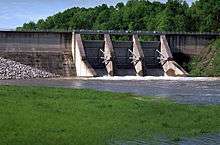Tellico Dam
| Tellico Dam | |
|---|---|
 Tellico Dam | |
| Location | Loudon County, Tennessee, United States |
| Coordinates | 35°46′40″N 84°15′35″W / 35.777778°N 84.259722°WCoordinates: 35°46′40″N 84°15′35″W / 35.777778°N 84.259722°W |
| Dam and spillways | |
| Impounds | Little Tennessee River |
| Height | 129 ft (39 m)[1] |
| Length | 3,238 ft (987 m)[1] |
| Reservoir | |
| Total capacity | 467,600 acre·ft (576,800 dam3)[1] |
| Catchment area | 2,627 sq mi (6,800 km2)[1] |
| Surface area | 14,200 acres (5,700 ha)[1] |
Tellico Dam is a dam built by the Tennessee Valley Authority (TVA) in Loudon County, Tennessee on the Little Tennessee River just above the main stem of the Tennessee River. It impounds the Tellico Reservoir.
Construction of the Tellico Dam was controversial and marks a turning point in American attitudes toward dam construction. Until the 1960s and 1970s, few questioned the value of building a dam; indeed, dams were considered to represent progress and technological prowess. During the twentieth century, the United States built thousands of dams.[2] By the 1950s, most of the best potential dam sites in the United States had been utilized and it became increasingly difficult to justify new dams, but government agencies such as TVA, the Bureau of Reclamation, and the Army Corps of Engineers continued to construct new dams. In the 1970s, the era of dam-building ended. The Tellico Dam case illustrates America's changing attitudes toward dams and the environment.
Construction of the dam was delayed when a small endangered fish called the snail darter was discovered on the Little Tennessee River. Dam opponents brought a lawsuit under the Endangered Species Act. The case, Tennessee Valley Authority v. Hill, 437 U.S. 153 (1978), made it to the Supreme Court of the United States.[3] In Hill, the Supreme Court affirmed, by a 6-3 vote, an injunction issued by a lower court to stop construction of the dam. Citing explicit wording of the Endangered Species Act (ESA) ensuring habitat for listed species is not disrupted, the Court said "it is clear that the TVA's proposed operation of the dam will have precisely the opposite effect, namely the eradication of an endangered species."[4] In the ensuing controversy over the snail darter, the Endangered Species Committee (also known as the "God Squad") was convened to issue a waiver for ESA protection of the snail darter. In a unanimous decision, the Committee refused an exemption of the Tellico Dam project. Charles Schulze, the chairman of the President's Council of Economic Advisers, later cited economic assessments that despite the Tellico Dam being 95% complete, "if one takes just the cost of finishing it against the benefits and does it properly, it doesn't pay, which says something about the original design."[5]
After a long battle, Congress finally exempted the Tellico Dam from the Endangered Species Act as an amendment in an unrelated bill. The gates were closed on the dam and Tellico Lake (a reservoir) began to form in 1979. Remnant populations of the snail darter were later located in other streams.[5]
The dam flooded the locations of the 18th century Overhill Cherokee towns of Chota, Tanasi, Toqua, Tomotley, Citico, Mialoquo and Tuskegee, as well as several prehistoric sites dating to as early as the Archaic period. The port of Morganton was also submerged.[6] Fort Loudoun was excavated; dirt was deposited to raise the site 17 feet (5 m), and the fort was rebuilt in its original location.[7]
Tellico Dam does not produce any electricity. However, the Tellico Dam complex directs almost all of the flow of the Little Tennessee River into a canal that enters the Tennessee River on the upstream side of Fort Loudoun Dam, thus adding 23 MW to the hydropower capacity at that dam.[8]
Tellico Village and other lakefront residential communities have been built along the shores of Tellico Lake.[8]
See also
References
- 1 2 3 4 5 "Tellico Dam". National Performance of Dams Program, National Inventory of Dams. Stanford University. Retrieved 2012-10-10.
- ↑ Marc Reisner, Cadillac Desert: The American West and Its Disappearing Water 165 (1986)
- ↑ Urschel, Donna (21 February 2014). "Zygmunt Plater to Discuss His Book "The Snail Darter and the Dam," March 13". Library of Congress. Retrieved 21 February 2014.
- ↑ Decision in TVA v. Hill, U.S. Supreme Court, 437 U.S. 153, decided June 15, 1978
- 1 2 Zygmunt Plater, "Tiny Fish/Big Battle." Tennessee Bar Journal 44, no. 4 (April 2008). Retrieved: 21 April 2008.
- ↑ Jefferson Chapman, Tellico Archaeology: 12,000 Years of Native American History (Tennessee Valley Authority, 1985).
- ↑ Vicki Rozema, Footsteps of the Cherokees: A Guide to the Eastern Homelands of the Cherokee Nation (Winston-Salem: John F. Blair), 135.
- 1 2 Jack Neely, "Tellico Dam Revisited." Originally published in the Metro Pulse Online. Accessed at the Internet Archive, 2 October 2015. (.doc format)
External links
| Wikimedia Commons has media related to Tellico Dam. |
- Tellico Reservoir — TVA site
- Tellico Reservoir — Tennessee Wildlife Resources Agency